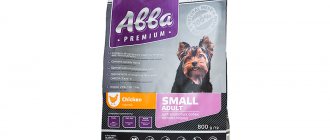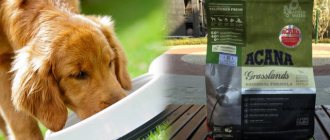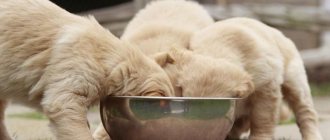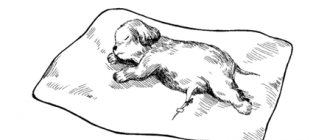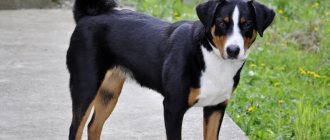Using dry dog food is very convenient - it is not surprising that many dog owners choose this feeding method. But a dog’s diet based on dry nutritional granules must be prepared according to the rules - in particular, a certain volume must be observed so that the animal does not starve or suffer from obesity. How many grams of dry food to give a dog per day is not an easy question, since not only the size of the dog is taken into account, but also a number of other factors.
What determines the size of the daily portion?
Despite the fact that every second dog eats dry food, not all owners know how to correctly calculate the amount of dry food for their pet. Proper calculation of a single serving is important for the health of the animal, since overfeeding can lead to obesity, and excess weight, in turn, will lead to other serious problems.
The food packaging usually lists the recommended daily allowance for a particular product. Quite often they are significantly overestimated, since manufacturers are simply not able to take into account all the features of your pet. Therefore, inexperienced dog breeders often consult dog trainers and veterinarians.
How much dry food a dog needs per day depends on the following factors:
- pet breed;
- weight and dimensional characteristics;
- lifestyle (where the pet lives, how many times it goes for walks, physical activity);
- age of the animal;
- physiological state (pregnancy or lactation, recovery from illness or surgery, and others);
- health status (presence of chronic diseases).
Thus, it is necessary to collect all individual information about the animal before calculating its daily nutritional intake. It is better if dry food is selected by the owner together with a veterinarian. Remember - under no circumstances should you overfeed the animal. It is completely normal for your dog to feel hungry during the day, which means he will have a good dinner. Excessive satiety only harms four-legged animals.
In general, the average daily intake of dry food for adult animals, depending on weight and physical activity, can range from 200 to 900 g per day. In this case, the dog needs to be fed 2 times a day. The nutrition of puppies follows a slightly different pattern - they are fed more often, dividing the daily portion into 3-6 meals.
We measure on scales
To determine the daily intake of dry food, you need to use a kitchen scale or, taking with you a bag of food, an empty container and a marker, go to the nearest supermarket, where there are check scales. They won’t refuse to weigh your food at the pet store either; by the way, there you can also ask for a measuring cup, which is produced by each manufacturer for their food.
Similar containers for the Acana and Orijen brands are very convenient, as they have marks for diets of different lines. One such cup will be enough for you to measure out food for different animals if they eat differently.
How many times a day do you feed a dog?
The frequency directly depends on the age of the animal. Puppies are given shorter intervals between feedings and a larger number of meals.
Puppy
From the age of three weeks, puppies begin to be accustomed to solid food. The number of feedings reaches 5-6 times a day.
Once the puppy reaches two months of age, the number of feedings is reduced to 3-4, after six months of age - to 2. Animals one year old and older, depending on their physical condition, are fed twice a day.
Adult
An adult dog is fed twice a day – in the morning and in the evening. It is necessary to observe a strict interval between serving food - 12 hours - and not move it under any circumstances. The regime can be broken if you need to fast before tests or surgery.
For pregnant females, the frequency of feedings is increased only in extreme cases - usually an increase in portion size is enough.
Adult dogs are fed three to six times a day if they are on a diet to treat a serious illness. When the pet’s well-being improves, the pet is transferred to the usual two meals a day.
How much food does a dog need per day: tables
You can independently calculate how much dry food your dog needs per day using a table that shows the required number of calories per day. In this case, you need to know the energy value of the selected food - it is indicated on the packaging.
Please note that premium and holistic food is more nutritious and you need a little less of it than a regular economy class product.
For puppies
To correctly calculate the amount of food for babies, you will need to know their weight and calorie content of food. Approximate data per 1 kg of weight can be seen in the table below.
| Puppy age (in months) | Daily kcal norm per 1 kg of weight in grams | Quantity of feed (in grams per 1 kg of body weight) |
| Up to 1 | 220-250 | 15-20 |
| 1-3 | 260-280 | 17-25 |
| 3-4 | 200-230 | 20-30 |
| 4-8 | 120-150 | 25-35 |
| 8-12 | 100-130 | Calculation for adult animals is used |
For small dogs, the portion will be smaller than for puppies of larger breeds.
Adults of small breeds
The daily allowance for adult small breeds (weighing up to 15 kg) is 300-400 g of food if we are talking about economy class, and 150-300 g if you give your pet premium or holistic.
| Dog weight, kg | Amount of feed during normal activity (grams per day) | Amount of feed at high activity (grams per day) |
| 2-5 | 30-80 | 50-100 |
| 5-9 | 100-160 | 160-200 |
For dogs whose weight starts from 10 kg, with good walking and play, 150-170 g are required, for their less active relatives - 120-150 g. Further, the rate of one serving increases by 100 g for every 10 kg. That is, if an animal weighs 20 kg, it needs 250-270 grams of food per day, 30 kg - 350-370 g, etc.
Adults of large breeds
Large and giant breeds include dogs weighing 35-65 kg or even more. Large animals need to be fed with a large amount of food, but overfeeding should not be allowed. The calculation is made according to the following table:
| Dog weight, kg | Amount of feed during normal activity (grams per day) | Amount of feed at high activity (grams per day ) |
| 30-39 | 400-440 | 410-500 |
| 40-49 | 450-520 | 500-600 |
| 50-60 | 520-650 | 600-700 |
Large breeds have a good appetite, but their metabolism is much slower than that of small breeds. Therefore, nutritious, but not too high-calorie food is produced for them.
You can't ignore your dog's individual needs. If you begin to notice that, while eating according to the norms on the packaging, the dog has begun to gain excessive weight, reduce the portions or remove one feeding. If he eats and asks for more, while losing weight, increase the portion or switch to a higher-calorie product.
If you don't have scales at hand
If you don’t have any measuring device at hand, then when going to the grocery store, take with you some dry food, a plastic cup and a marker. Any supermarket has check scales where you can weigh the portion of dry food you need. You can also go to a pet store, where they often sell food in bulk, and they can help you there too.
As a last resort, you can use the mathematical method by dividing the total weight of the package by 60 and obtaining the number of parts of the required weight. True, it will not always be possible to do this accurately, but you will get an approximate figure. Then you need to scatter the contents of the bag into the required number of plastic cups in equal quantities - and here is your daily requirement of 60 g.
Some craftsmen manage to apply Archimedes' law in everyday life: they throw a plastic bag of food into the water and then measure the splashed milliliters, converting them into grams (1 ml of water is the same as 1 gram). But it is obvious that you will get an adequate result only by achieving laboratory accuracy. We still advise you to use a scale - this way you will be sure that your pet is getting as much food as it needs.
Source
Calculation of dog food for 1 serving
Knowing the daily volume of food, it is not difficult to calculate the amount of granulated food served in one feeding.
How to determine the mass of a serving
How to calculate the amount of food for a dog: you need to divide the daily amount by the number of feedings; for adult animals this is two. The amount of food per 1 kg of body weight per day for an adult dog depends on the breed, weight and calorie content of the food (see above).
Active animals, service dogs or athletes need special consideration, as well as pregnant and lactating women. To the usual dosage of dry dog food, approximately 1/3 of the serving is added for working dogs and 1/4 for pregnant and lactating dogs. If the dog is elderly and inactive, the portion should be reduced by about 1/3.
How to measure the required weight
It’s definitely not possible to measure dry food without a scale. Therefore, if you want to know the perfectly accurate amount of feed, you will have to purchase a kitchen scale.
Manufacturers of some expensive foods include special measuring cups in the pack, with which you can pour the desired portion. However, it is worth remembering that such a container is designed only for this brand, because all dry products have granules of different densities, sizes and weights.
If you count only approximately, the food can be poured into a 100 ml cup - it will be about 240-250 grams. When buying food in bulk, you can ask the seller to divide the product into several parts equal to the daily feeding rate. And at home you can simply divide them in half: for breakfast and dinner.
Just not by eye!
Whichever measurement method you use from the above, as a result you will receive an accurate answer to the question of how much is 60 grams of dry food, and this is very important. It is highly not recommended to sprinkle food by eye, because you will definitely make a mistake, and, most likely, a big one. This will lead to systematic overfeeding of the animal, causing it to become overweight with all the accompanying problems.
Therefore, in order not to run around shopping, we advise you to purchase kitchen scales that everyone can afford, and follow the recommended daily allowances, adjusted to the individual needs of the animal.
Source
Soaking the feed
If the manufacturer does not indicate restrictions on soaking the feed and such information is not on the packaging, the granules can be soaked. It is especially useful to do this for older dogs, sick individuals and puppies up to three months old.
To do this, you need to fill the granules by half or a third with unboiled drinking water, heated to about 40°C. Boiled milk is sometimes added to the puppy.
Soaked food cannot be stored for a long time - a maximum of three hours. It is dangerous to use it after longer storage, as it turns sour very quickly. Regardless of whether the dog eats dry food or soaked food, the norm is the same.
Drinking regime for “dry feeding”
If the animal is fed only dry foods, then the required daily amount of liquid is calculated using the formula: 50 ml of water per kg of body weight.
Of course, you don’t need to give your dog water at certain intervals. She should have a free approach to drinking water and satisfy her own needs. And needs may vary depending on numerous conditions: age, physical activity, time of year, etc.
The water should always be clean - it needs to be changed every few hours. If this is not possible, a special automatic drinking bowl for dogs will come to the rescue. You should not use boiled water: the best option would be filtered or bottled water without gas. Raw water is strictly prohibited.


